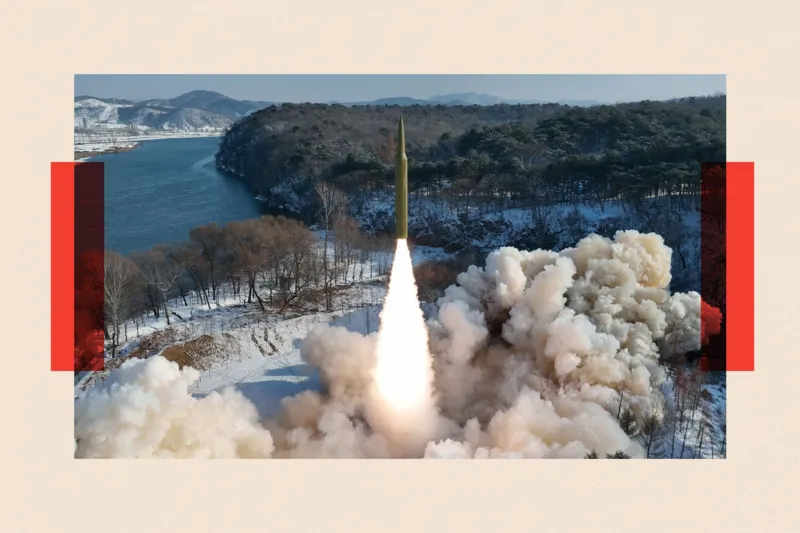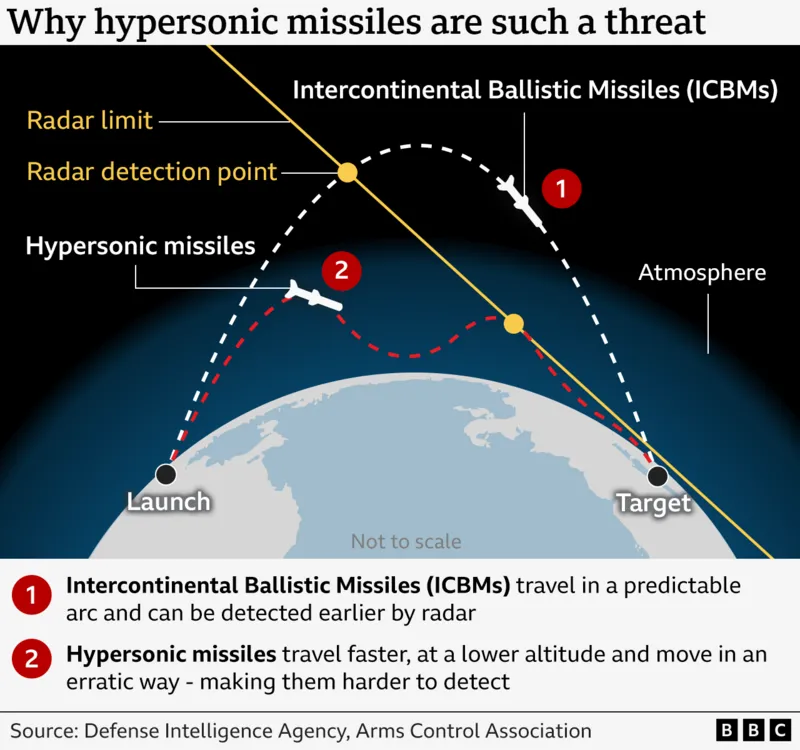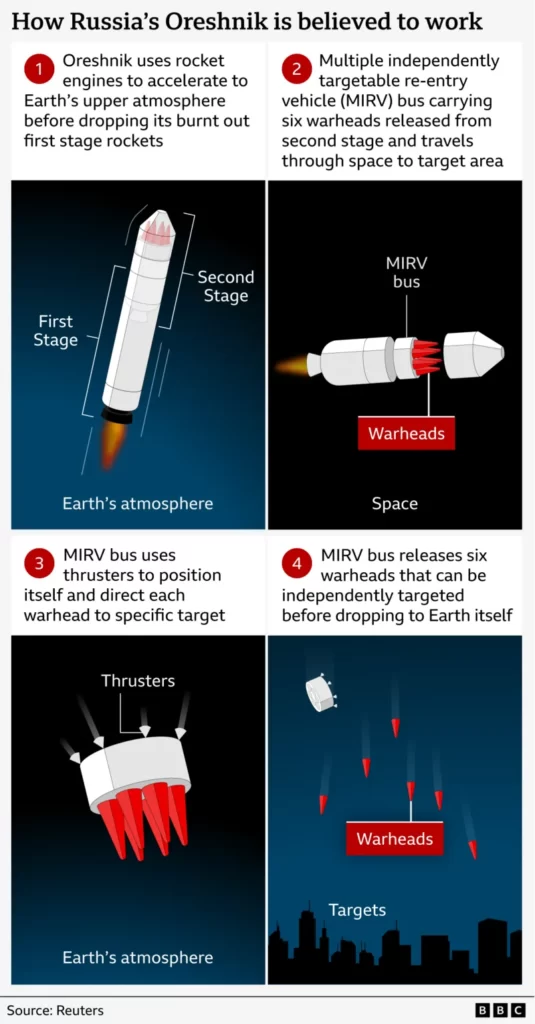The hypersonic missile race is accelerating across the globe, as China, Russia and the United States compete to dominate a weapons technology that could change the future of warfare. Travelling at more than five times the speed of sound, hypersonic missiles are fast, manoeuvrable and extremely difficult to intercept, raising the stakes in today’s geopolitical contests.
The rise of China’s DF-17
Glinting in the autumn sun on a parade ground in Beijing, the People’s Liberation Army missiles moved slowly past the crowd on a fleet of giant camouflaged lorries. Needle-sharp in profile, measuring 11 metres long and weighing 15 tonnes, each bore the letters and numerals: “DF-17”.
China had just unveiled to the world its arsenal of Dongfeng hypersonic missiles. That was on 1 October 2019 at a National Day parade. The US was already aware that these weapons were in development, but since then China has raced ahead with upgrading them.
Thanks to their speed and manoeuvrability- travelling at Mach 5 and beyond- they represent a formidable shift in military power. So much so, that they could fundamentally alter the way wars are fought.
“This is just one component of the wider picture of the emerging geopolitical contest that we’re seeing between state actors,” says William Freer, a national security fellow at the Council on Geostrategy think tank. “It’s one we haven’t had since the Cold War.”
Russia, China and the US in competition
The Beijing ceremony raised speculation about the scale of China’s technological leap. Today, China leads the field in hypersonic missiles, followed closely by Russia. The US, meanwhile, is playing catch-up, and the UK has none.
Freer argues that the reason China and Russia are ahead in the hypersonic missile race is straightforward: “They decided to invest a lot of money in these programmes quite a few years ago.”
For much of the first two decades of the century, Western nations focused their resources on fighting terrorism at home and counter-insurgency wars overseas. Peer-on-peer conflict against a modern, sophisticated adversary seemed a distant prospect.
“The net result is that we failed to notice the massive rise of China as a military power,” admitted Sir Alex Younger, the former head of Britain’s Secret Intelligence Service, after retiring in 2020.
Other nations are also developing hypersonic capabilities. Israel has the Arrow 3, designed as an interceptor. Iran has claimed to possess hypersonic missiles, and even used one during a 12-day war with Israel in June — although experts doubted it met the criteria for true manoeuvrability. North Korea has been developing its own versions since 2021, and insists it now has a working weapon.
The US, determined not to fall behind, has debuted its “Dark Eagle” hypersonic weapon. According to the Pentagon, it represents “the spirit and lethality of the Army and Navy’s hypersonic weapon endeavours.” But analysts agree: China and Russia remain far ahead.

Hyper fast and hyper erratic
By definition, hypersonic means travelling at Mach 5 or faster — five times the speed of sound, or 3,858 mph. That puts them in a league of their own compared to supersonic missiles (above 767 mph).
The fastest so far is Russian: the Avangard. Moscow claims it can reach Mach 27 (20,700 mph), although Mach 12 (9,200 mph) is more often cited. That is two miles a second.
Unlike conventional ballistic missiles, which travel in predictable arcs, hypersonic glide vehicles can shift course mid-flight, making them almost impossible to track and intercept.
There are two types:
- Boost-glide missiles, like China’s DF-17, which are launched into the upper atmosphere before plunging down at extreme speed.
- Hypersonic cruise missiles, which hug terrain at low altitude to avoid radar detection, powered by scramjet engines that scoop air as they fly.
Both can carry either nuclear or conventional warheads, making them “dual-use” weapons. But their advantage is less about raw destructive power and more about the difficulty of detecting and stopping them.
“By flying under the radar horizon they can evade early detection and may only appear on sensors in their terminal flight phase, limiting interception opportunities,” explains Patrycja Bazylczyk of the Missile Defence Project at CSIS in Washington DC. She believes stronger space-based sensors are essential to countering the threat.

Russia’s claims under scrutiny
Russia has promoted its role in the hypersonic missile race with weapons such as the Kinzhal and Avangard. President Vladimir Putin has boasted that they are unstoppable, capable of turning targets “to dust.”
But not all the claims stand up. Ukraine has shot down several Kinzhals, casting doubt on whether they are truly hypersonic. In 2024, Moscow tested a missile dubbed the “Oreshnik” over Ukraine, reportedly reaching Mach 11. Yet its warheads were inert, causing limited damage.
“On Russia, we should be cautious,” says Freer. While Avangard remains a concern, experts like Dr Sidharth Kaushal of RUSI suggest its production capacity is limited. Its primary purpose may be to overwhelm US missile defences, rather than redefine warfare.
Still, with some Russian systems stationed in Kaliningrad, close to NATO territory, the potential threat to Europe cannot be dismissed.

China’s growing dominance
China, meanwhile, continues to expand its arsenal at speed. In late 2024 it unveiled the GDF-600, a hypersonic glide vehicle with a 1,200kg payload, capable of carrying sub-munitions and travelling at Mach 7.
Beijing now commands the world’s most powerful hypersonic arsenal, giving it strategic leverage in the South China Sea and across the Pacific. For the US Navy, tasked with operating in those waters, the challenge of facing China’s hypersonic missiles is already a central strategic concern.
The UK and the struggle to catch up
The UK is lagging in the hypersonic missile race, despite being one of the UN Security Council’s five nuclear powers. In April, however, the Ministry of Defence announced a “milestone moment” after propulsion tests at NASA’s Langley Research Centre in Virginia.
A collaboration between the UK government, defence industry and the US, the programme achieved 233 successful static tests over six weeks. Defence Secretary John Healey hailed the achievement — but experts warn an operational weapon is still years away.
Western analysts argue that catching up will mean not just developing hypersonic missiles, but also investing heavily in defence against them. “It’s about two sides of the same coin,” says Freer. “You need to defend yourself, but also be able to strike the enemy’s launch platforms.”
Are hypersonics overhyped?
Some experts believe the hypersonic missile race has been overstated. Dr Kaushal argues that while their speed and manoeuvrability make them effective against hardened targets, existing defensive measures can still work.
Tom Sharpe, a former Royal Navy Commander, agrees: “The basics of needing to track your enemy, fire at them, and manoeuvre late on are no different. You just have less time.”
Commercial satellite imagery, for instance, is often outdated by minutes, limiting its use in targeting. Advances in artificial intelligence and real-time satellite tracking could change that, but the race between attack and defence is far from settled.
Conclusion
Whether overhyped or not, the hypersonic missile race is reshaping global security. For now, China and Russia lead, while the US and its allies scramble to catch up. What is clear is that these Mach 5+ weapons- fast, manoeuvrable, and hard to stop- are forcing militaries worldwide to rethink the future of deterrence, defence and war.
Source: BBC
Also read: Iran hypersonic missiles fired amid ongoing conflict
For more videos and updates, check out our YouTube channel.


